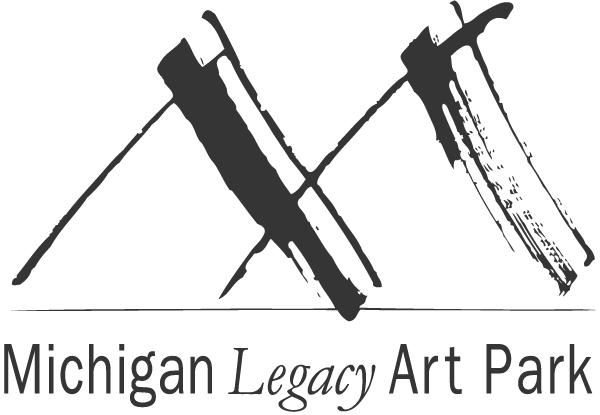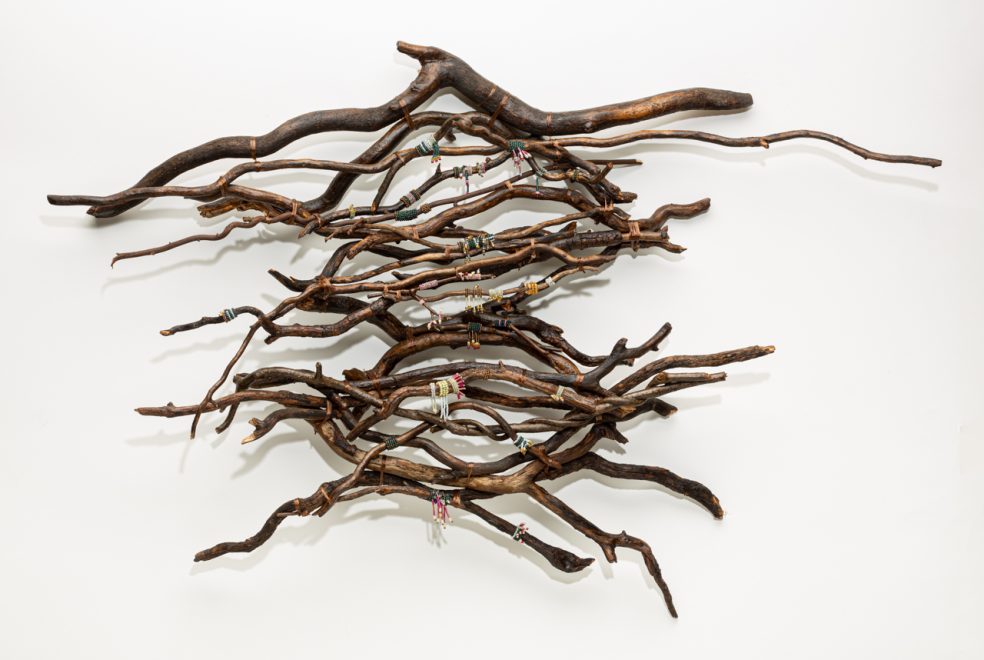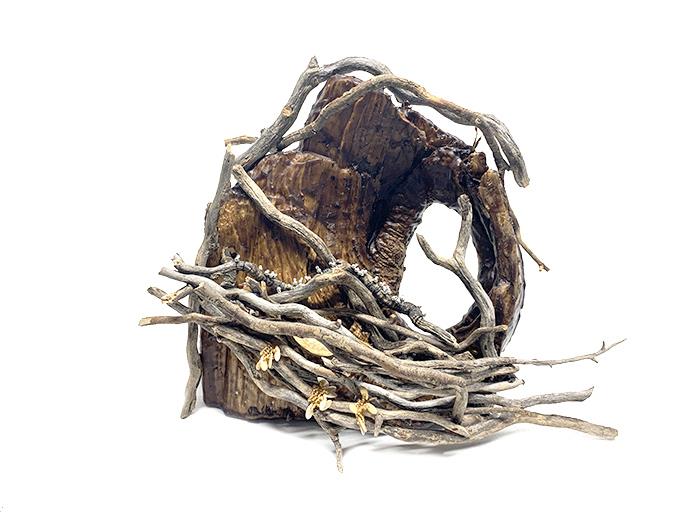Michigan Legacy Art Park is pleased to announce its 2023 David Barr Artist in Residence, Dawnice Kerchaert. A Pontiac-based artist, Kerchaert brings a profound connection to nature that aligns perfectly with the mission and vision of Michigan Legacy Art Park. Her work is a celebration of the natural world, inviting viewers to pause and appreciate the often-overlooked textures and forms of the environment.
Enjoy some of Dawnice’s thoughts on her upcoming residency below, and make plans to join us at the Art Park on Friday, October 20 at 5:30 PM for a public presentation of her work and process.
Dawnice Kerchaert Interview
Can you tell us about your background and what led you to become an artist working with natural materials?
As a child my family took summer vacations, initially in St Ignace just across the bridge. My mother had family there and we camped in areas along Lake Michigan. We also visited an aunt & uncle in Harrietta who had property and a small farm. We could walk to the fish hatchery and feed the fish. We were outdoors all of the time. The experience stayed with me. Over the years I have learned many things about being an artist, especially skills in different media. It wasn’t until years later while I was working in advertising design that I became interested in making sculpture. Then a few years later when I was involved in bronze casting that natural materials came into my work. I used the lost wax process of casting to make bronze branches and nests. I then began working directly with the natural materials. So, it was a long journey getting to this point. I have always enjoyed the experience of being in beautiful nature. I attempt to express these feelings in my work.
What role does storytelling play in your art, especially in the context of Michigan’s history?
Working with natural materials began as an interest in the forms, textures, and colors I found. Over time I have become more interested in identifying and learning more about what I find and collect. For example, identifying trees, learning about what is native to a place and what has been transplanted from somewhere else. Broadening the perspective of how all these parts of nature are interconnected. When reading about Native American culture I quickly learned of their symbiotic relationship with nature. This is apparent in everything. I look to learn what I can through their craft. I do not imitate their work but learn from them. Nature has played a role in my desire to learn more about Native American culture. The storytelling is still in the developmental process.
How do you balance the organic and unpredictable nature of natural materials with your artistic vision?
From the start this has been the challenge. How to take these parts of nature I have collected and make them into something more permanent. It took a while but through trial and error, experimenting with different kinds of preservatives and adhesives, I turned to something more natural and non toxic. I use beeswax to seal and protect, and in some examples to strengthen. Not everything I find is suitable for a final work of art, but everything can spur inspiration.
Are there any cultural or historical influences that inform your artistic choices?
The most influential has been researching Native American craft and culture. They have been working with natural materials for thousands of years and have great knowledge of nature and how to work with its bounty. I turned to working with pine needles. I learned the process and technique through research. And the internet has informative videos on how to do this as well. I have developed a great appreciation and respect for nature.
How does the environment and nature influence your creative process?
Nature quite literally inspires through interactive experiences such as smells, sounds, temperature, tactile qualities as well as what I observe visually. I am always finding something new to me. I am curious and want to find out more about it. This is how it begins.
Can you describe the concept or theme behind your upcoming artist residency at Michigan Legacy Art Park?
This is my first time working with leaves. I will create a work that displays the leaves as falling, suspended in space. I will use the beeswax to protect and prolong the life of the piece. My desire is to have the leaves seem to float and fall and move, and blend with the surroundings. Leaves falling are beautiful and signal the end of a season. It is contemplative, a moment to pause and consider the time before the snow falls.
What do you hope to achieve or explore during your time at the art park?
The solitude and uninterrupted peace and beauty of the place allows for inspiration. I am bringing binoculars for bird watching, taking many pictures of nature, and will find a place to sit and take in the surroundings. The woods are full of inspiration.
How do you select the specific natural materials you use in your artwork?
When I am exploring the easiest and least disruptive way to collect materials is to look on the ground. Branches, vines, tree bark, seed pods, pine needles are some of the things I collect. They are interesting in their shapes and textures. Other things, like mushrooms or flowers, are too delicate to work with so I will take pictures to use as references.
What techniques do you employ to transform these materials into art?
First I make sure they are free from insects and debris before I take them inside my studio. Most of the materials I work with are dried and found on the ground. Things like seed pods must be completely dried. In most cases I seal everything in beeswax. The pine needles I collect are washed, then briefly steeped in boiling water then dried. I use the pine needles to coil into shapes. As they are thoroughly cleaned they do not need the beeswax to preserve. To assemble materials into sculpture I use artificial sinew which is very strong and made for this kind of work.
Are there any particular challenges or constraints you face when working with natural materials?
The materials are often fragile. For the really delicate materials I use the wax to protect and strengthen then a small needle and thread to sew into assemblages. For something like tree bark which is stronger I use the artificial sinew. I tie branches together and sew other materials to this. You cannot screw, nail, glue or tape these materials, It just doesn’t work.
What role does experimentation play in your artistic journey?
My process is entirely experimental. I have worked in a variety of media including wood fabrication and metal casting, and none of those processes works for natural materials. It is truly a challenge and I learn as I go.
Can you describe a piece of artwork that was particularly challenging or transformative for you?
For about the first two years when I first started working directly with natural materials, I made and exhibited some interesting pieces. One was a bowl made of tree bark, natural grasses, and the cottony material from milkweed pods. The materials were assembled dried, I formed the bowl shape using paper mache’, and used adhesives to hold it all together. A year later I found it had been devoured by mice in my studio. So, no more paper mache’ or adhesives or anything that would be food for mice or anything else. It became important to let go of the artificial and look for resolutions using natural materials. To learn from nature. It was at this time that I turned to researching Native American examples. It was also at this time I began the practice of coiling pine needles.
What do you hope visitors will take away from your residency exhibition at Michigan Legacy Art Park?
To view art in the woods of Michigan Legacy Art Park is a double pleasure. You can see the different ways artists interact in the environment. For me, the trees are inspiring. Their leaves are just one part of the amazing forest. Their beauty is uplifting. Take a closer look at some detail in nature; a texture, a pattern, a color, a scent and see where it may lead you. I hope to celebrate the pleasure of the place and also inspire curiosity. Nature is a great teacher.
Do you collaborate with other artists or experts in related fields to enhance your work?
I have not done collaborations with others. I am open to it, of course it just takes the right people and ideas to make it all come together.
What advice would you give to emerging artists interested in working with natural materials?
Don’t hesitate to explore new ideas or materials. Hone your instincts and go with what feels right to you. There are MANY other artists who work with natural materials that are doing amazing things. Check out the website Colossal.com to see unique approaches, many that are nature related. Look up Native American art, look up Susanna Bauer and Willary Waters who do needle work on leaves. Develop your own ideas.
Can you share any upcoming projects or ideas you’re excited about after your residency?
I will be going to Sault Saint Marie Michigan to immerse myself in a different environment on the shore of Lake Superior. For ten days in November I will stay in a cabin on the beach as the Point Iroquois Artist In Residence, sponsored by the Sault Area Art Center. It is a new place for me and I am looking forward to the experience of Lake Superior and how I can translate it into my art.





